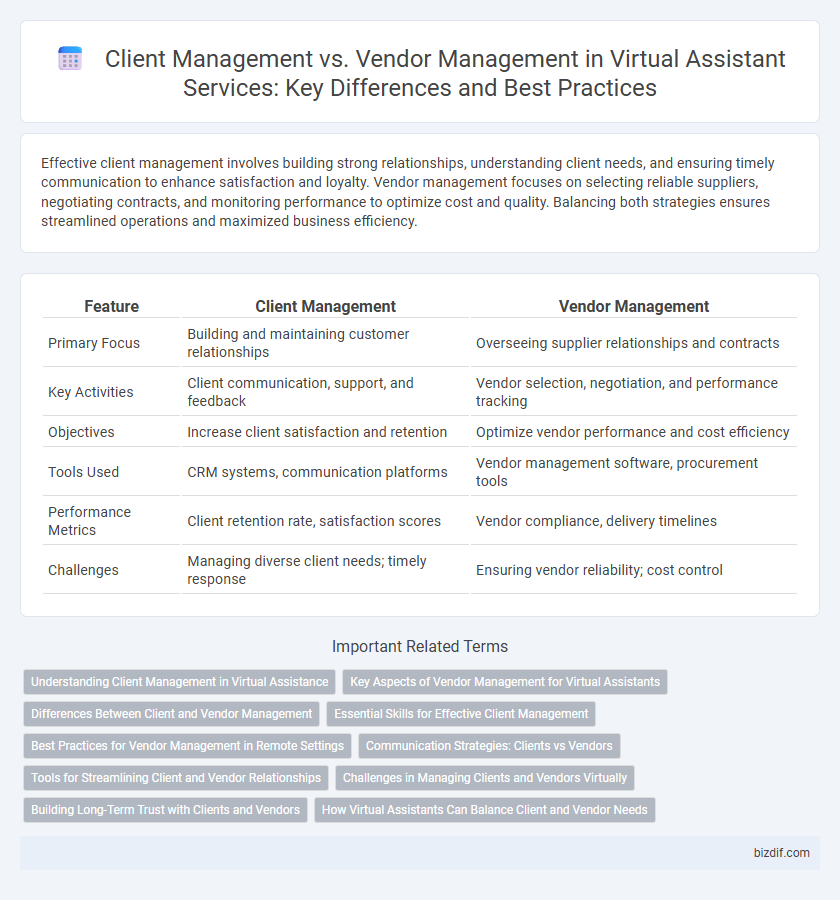Effective client management involves building strong relationships, understanding client needs, and ensuring timely communication to enhance satisfaction and loyalty. Vendor management focuses on selecting reliable suppliers, negotiating contracts, and monitoring performance to optimize cost and quality. Balancing both strategies ensures streamlined operations and maximized business efficiency.
Table of Comparison
| Feature | Client Management | Vendor Management |
|---|---|---|
| Primary Focus | Building and maintaining customer relationships | Overseeing supplier relationships and contracts |
| Key Activities | Client communication, support, and feedback | Vendor selection, negotiation, and performance tracking |
| Objectives | Increase client satisfaction and retention | Optimize vendor performance and cost efficiency |
| Tools Used | CRM systems, communication platforms | Vendor management software, procurement tools |
| Performance Metrics | Client retention rate, satisfaction scores | Vendor compliance, delivery timelines |
| Challenges | Managing diverse client needs; timely response | Ensuring vendor reliability; cost control |
Understanding Client Management in Virtual Assistance
Client management in virtual assistance involves building strong relationships, understanding client needs, and delivering personalized support to enhance satisfaction and loyalty. Effective client management requires clear communication, timely responsiveness, and proactive problem-solving to ensure project goals are met efficiently. Prioritizing client management over vendor management helps virtual assistants focus on client retention and business growth.
Key Aspects of Vendor Management for Virtual Assistants
Key aspects of vendor management for virtual assistants include evaluating vendor reliability, negotiating contracts, and maintaining clear communication channels to ensure service quality and timely deliverables. Monitoring vendor performance and managing relationships effectively help reduce risks and optimize operational efficiency. Implementing proper vendor management tools and tracking payment schedules also contributes to streamlined workflows and cost control.
Differences Between Client and Vendor Management
Client management centers on building and maintaining strong relationships, ensuring satisfaction, and understanding client needs to drive loyalty and repeat business. Vendor management focuses on negotiating contracts, monitoring supplier performance, and managing procurement processes to optimize cost, quality, and delivery timelines. Key differences include the nature of interactions--client management prioritizes customer experience and retention, while vendor management emphasizes supply chain efficiency and risk mitigation.
Essential Skills for Effective Client Management
Effective client management requires strong communication skills, empathy, and the ability to anticipate client needs to build trust and long-term relationships. Proficiency in project management tools, conflict resolution, and personalized service ensures clients feel valued and their expectations are consistently met. Mastering these skills enhances client satisfaction and drives business growth in virtual assistant roles.
Best Practices for Vendor Management in Remote Settings
Effective vendor management in remote settings requires establishing clear communication channels and setting precise expectations through detailed contracts and service level agreements (SLAs). Implementing regular performance reviews using key performance indicators (KPIs) ensures accountability and facilitates timely issue resolution. Leveraging digital collaboration tools and centralized platforms enhances transparency and streamlines coordination between virtual assistants and vendors.
Communication Strategies: Clients vs Vendors
Effective communication strategies for client management prioritize personalized updates, proactive problem-solving, and clarity to build trust and long-term relationships. Vendor management communication focuses on precise contract terms, regular performance reviews, and timely issue resolution to ensure service quality and compliance. Tailoring approaches by aligning communication frequency and tone with the unique objectives of clients and vendors enhances operational efficiency and collaboration.
Tools for Streamlining Client and Vendor Relationships
Effective client management tools like CRM software streamline communication, track interactions, and manage sales pipelines, enhancing customer satisfaction and retention. Vendor management platforms automate procurement, monitor supplier performance, and ensure compliance, optimizing operational efficiency and reducing risks. Integrating these tools supports seamless collaboration, consolidates data insights, and drives strategic decision-making in virtual assistant workflows.
Challenges in Managing Clients and Vendors Virtually
Managing clients virtually presents challenges such as maintaining clear communication, ensuring timely feedback, and building trust without face-to-face interactions. Vendor management struggles include coordinating deliveries across different time zones, verifying quality remotely, and handling contract compliance without physical oversight. Both require robust digital tools and proactive strategies to overcome barriers in virtual collaboration.
Building Long-Term Trust with Clients and Vendors
Building long-term trust with clients requires consistent communication, personalized service, and delivering on promises to enhance client satisfaction and loyalty. Vendor management centers on transparent negotiation, timely payments, and mutual benefits to establish dependable partnerships. Both robust client and vendor relationships are essential for virtual assistants to ensure smooth operations and sustainable business growth.
How Virtual Assistants Can Balance Client and Vendor Needs
Virtual assistants expertly balance client and vendor needs by streamlining communication, ensuring prompt responses, and managing schedules to align deliverables from both parties. They utilize project management tools to track progress and prioritize tasks, maintaining transparency and fostering trust across all stakeholders. This coordination enhances efficiency, allowing virtual assistants to meet client expectations while supporting vendor timelines and quality standards.
Client management vs Vendor management Infographic

 bizdif.com
bizdif.com